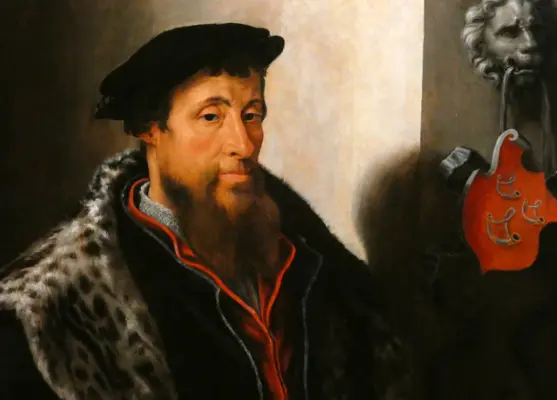The 1555 portrait servais germany by the enigmatic artist Servais Germany invites viewers into a world where realism and history intertwine. This striking piece, rich in detail and emotion, not only captures the likeness of its subject but also provides a window into the cultural landscape of the mid-16th century. As you gaze upon this artwork, you can’t help but feel drawn to its story—a narrative woven through brush strokes and pigments that transcends time. Join us on an exploration of this extraordinary portrait, as we uncover the historical context behind it, delve into the techniques employed by Servais Germany, and reflect on how this masterpiece continues to influence art today.
Historical Context of the Portrait
The 1555 portrait servais Germany emerges from a fascinating historical backdrop. This period was marked by the Renaissance, a time that celebrated humanism and individual achievement. Artists sought to capture not just likeness but also character.
During the mid-16th century, Europe was undergoing significant political and social transformations. The Reformation challenged established norms, affecting artistic expression and patronage. Art became intertwined with identity, reflecting both personal and collective values.
In addition to these shifts, portraiture gained prominence as a way for individuals to assert their status in an increasingly competitive society. Wealthy patrons commissioned works that highlighted their importance within their communities.
This context shaped how Servais approached his subject matter—evident in the detailed rendering of facial features and clothing styles typical of his client’s aspirations at the time. Each brushstroke tells a story far beyond mere representation.
Analysis of the Artist, Servais Germany
1555 portrait servais Germany stands as a pivotal figure in the realm of 16th-century portraiture. His work is characterized by an intimate approach to realism, creating a genuine connection between the subject and the viewer.
Emerging from the Northern Renaissance, he blended meticulous detail with vibrant color palettes. This combination allowed him to breathe life into his subjects, making them more than mere images on canvas.
Germany’s background in Flemish art deeply influenced his technique. He mastered light and shadow, enhancing dimensionality within his portraits. Each brushstroke reveals not just skill but also an understanding of human emotion.
His portrayal of individuals went beyond their physical appearance; it captured their essence. This commitment to authenticity set him apart from many contemporaries who often leaned towards idealization rather than realism.
The 1555 Portrait of Servais exemplifies these qualities beautifully, showcasing Germany’s ability to merge artistry with true representation.
Techniques used in the 1555 portrait servais germany
The 1555 portrait servais germany showcases remarkable techniques that define its realism. One notable method is the use of chiaroscuro. This technique creates a striking contrast between light and shadow, giving depth to the figure.
Servais Germany also employed meticulous brushwork. Each stroke contributes to lifelike textures in fabrics and skin tones. The attention to detail enhances the emotional resonance of the subject.
Layering is another critical aspect of this artwork. Multiple layers create richness in color and allow for subtle variations in hue. This approach makes the portrait visually engaging.
Perspective plays a vital role as well. By positioning Servais slightly off-center, Germany invites viewers into an intimate dialogue with the painting. Such thoughtful composition draws one’s eye directly to the captivating expression held within those painted features.
Comparison to Other Portraits from the Same Era
When examining the 1555 portrait servais germany, it is essential to contrast it with other notable works from the same period. The mid-16th century was rich in artistic expression, marked by a wave of realism.
For instance, portraits by Hans Holbein the Younger exhibit meticulous detail and an almost photographic quality. Holbein’s subjects often possess a certain nobility that differs from the more intimate portrayal found in Servais’s work.
Additionally, Titian’s masterpieces reflect vibrant colors and dynamic compositions. His figures exude life and movement, creating a stark contrast to the stillness seen in Germany’s portraiture.
In this era, artists were exploring individuality alongside societal roles. While some opted for grandeur and opulence, Servais chose genuine representation over embellishment. This choice sets his work apart within its historical context while highlighting varying approaches to capturing human essence through art.
Influence and Legacy of the 1555 portrait servais germany
The 1555 portrait servais germany holds a significant place in art history. Its realism and emotional depth influenced not only contemporaries but also future generations of artists.
This portrait encapsulates the essence of Northern Renaissance portraiture, merging meticulous detail with humanistic expression. Artists like Hans Holbein and Pieter Paul Rubens drew inspiration from its lifelike qualities.
Beyond aesthetics, the painting contributed to discussions around identity and status during its time. It challenged traditional representations by emphasizing individuality over generic ideals often found in earlier works.
Collectors began to recognize the value of capturing personal narratives through portraiture, paving the way for modern artistic expressions. The legacy of this masterpiece can still be felt today as it continues to inspire studies on character representation in contemporary art practices.
Conclusion: 1555 portrait servais germany
The 1555 portrait servais germany remains a significant piece that transcends its historical context. It captures not just the likeness of its subject but offers insight into the era’s cultural and artistic movements. The realism depicted in this portrait reflects an evolving appreciation for human emotion and individuality, pushing boundaries for future artists.
Servais Germany’s techniques showcase meticulous attention to detail, making his work stand out among his contemporaries. When compared to other portraits from the same period, the uniqueness of this piece becomes more apparent. The composition, use of color, and texture create a rich visual experience that invites viewers to explore the deeper meanings behind the artwork.
Its influence extends beyond its immediate impact; it laid the groundwork for later developments in portraiture that celebrate both form and narrative depth. As art continues to evolve, works like the 1555 Portrait serve as vital links connecting us with our shared history.
